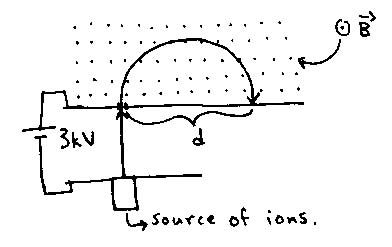


Next: Problem 2
Up: No Title
Previous: No Title
1.) (10 points) A 58Ni ion has a charge of +e and a
mass of  is accelerated through a potential
difference of 3 kV and deflected in a magnetic field of 0.12 T. It
follows the path shown below.
is accelerated through a potential
difference of 3 kV and deflected in a magnetic field of 0.12 T. It
follows the path shown below.
a) How far down from where the ion entered will it strike
the wall? In other words, find the distance d.
(Hint: Think about conservation of energy)
b) We know that mixed in with our 58Ni ions, we have a
few 60Ni ions. They have the same charge, just a greater mass.
(Assume the mass ratio is excatly 58/60) How far from where the
58Ni ions strike the wall do the 60Ni ions strike?

Answer:
a)
Starting with the equation that

We have that the potential energy of the particles entering the B
field is given by

Solving this for the velocity that the ions have when they enter the
region of B field, we find that


v = 99900 m/s
Now, we know that the force acting of the particles by the magnetic
field will cause them to move in a circular orbit, so we see that


Solving for the radius, we find that

Putting our value for the velocity in to this equation, we see that
r = .501 m
So, the distance d = 2r is given by
d = 1.002 m
b)
Now the mass is given by


So, the velocity is now
v60 = 98200 m/s
and the radius is
r60 = .509 m
And the distance d60 is given by
d60 = 2r60
d60 = 1.017 m
So, the difference in where the 58Ni ions hit and where the
60Ni ions hit is given by





Next: Problem 2
Up: No Title
Previous: No Title
Jason George Zeibel
4/3/1998
